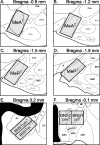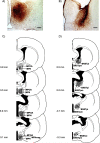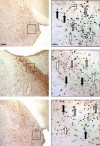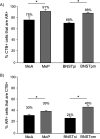Chemosensory and hormone information are relayed directly between the medial amygdala, posterior bed nucleus of the stria terminalis, and medial preoptic area in male Syrian hamsters
- PMID: 21316366
- PMCID: PMC3081384
- DOI: 10.1016/j.yhbeh.2011.02.005
Chemosensory and hormone information are relayed directly between the medial amygdala, posterior bed nucleus of the stria terminalis, and medial preoptic area in male Syrian hamsters
Abstract
In many rodent species, including Syrian hamsters, the expression of appropriate social behavior depends critically on the perception and identification of conspecific odors. The behavioral response to these odors is mediated by a network of steroid-sensitive ventral forebrain nuclei including the medial amygdala (Me), posterior bed nucleus of the stria terminalis (BNST), and medial preoptic area (MPOA). Although it is well-known that Me, BNST, and MPOA are densely interconnected and each uniquely modulates odor-guided social behaviors, the degree to which conspecific odor information and steroid hormone cues are directly relayed between these nuclei is unknown. To answer this question, we injected the retrograde tracer, cholera toxin B (CTB), into the BNST or MPOA of male subjects and identified whether retrogradely-labeled cells in Me and BNST 1) expressed immediate early genes (IEGs) following exposure to male and/or female odors or 2) expressed androgen receptor (AR). Although few retrogradely-labeled cells co-localized with IEGs, a higher percentage of BNST- and MPOA-projecting cells in the posterior Me (MeP) expressed IEGs in response to female odors than to male odors. The percentage of retrogradely-labeled cells that expressed IEGs did not, however, differ between and female and male odor-exposed groups in the anterior Me (MeA), posterointermediate BNST (BNSTpi), or posteromedial BNST (BNSTpm). Many retrogradely-labeled cells co-localized with AR, and a higher percentage of retrogradely-labeled MeP and BNSTpm cells expressed AR than retrogradely-labeled MeA and BNSTpi cells, respectively. Together, these data demonstrate that Me, BNST, and MPOA interact as a functional circuit to process sex-specific odor cues and hormone information in male Syrian hamsters.
Published by Elsevier Inc.
Figures









References
-
- Baum MJ, Everitt BJ. Increased expression of c-fos in the medial preoptic area after mating in male rats: role of afferent inputs from the medial amygdala and midbrain central tegmental field. Neuroscience. 1992;50:627–46. - PubMed
-
- Baum MJ, Kelliher KR. Complementary roles of the main and accessory olfactory systems in mammalian mate recognition. Annu Rev Physiol. 2009;71:141–60. - PubMed
-
- Been L, Petrulis A. Society for Neuroscience. Washington, D.C.: 2008. The role of the posterior bed nucleus of the stria terminalis in opposite-sex odor preference and sexual odor processing in male Syrian hamsters. - PubMed
Publication types
MeSH terms
Substances
Grants and funding
LinkOut - more resources
Full Text Sources
Research Materials

